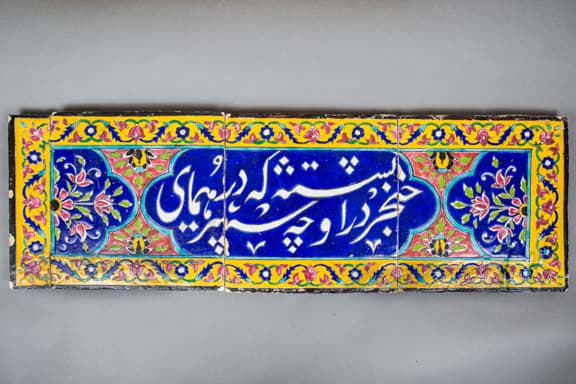Set of Three Tiles with Farsi Inscription Among Floral Decoration, 18th Century CE - 19th Century CE
Terracotta
CB.3550
This beautiful set of tiles showcases the delicate and refined taste of Qajar Artists between the 18th and 19th centuries. An outer decoration is composed of a bordure with yellow...
This beautiful set of tiles showcases the delicate and refined taste of Qajar Artists between the 18th and 19th centuries. An outer decoration is composed of a bordure with yellow background bearing floral patterns. The central section displays further floral motifs, realised with exceptional care and refinement, enclosing a calligraphic inscription in Farsi reading: "A dagger inside his body, like a gryphon through the sky". This is an impressive work of art, testifying to the cultural advancements and artistic distinction of Persia in the Early Modern period.
The Qajar dynasty was an Iranian royal dynasty of Turkmen tribal origin, specifically from the Qajar tribe, which ruled then Persia, nowadays the Islamic Republic of Iran, from 1785 to 1925. The state ruled by the Qajar dynasty was officially known as the Sublime State of Iran. Although the Qajar family took full control of Iran in 1794 and re-asserted Iranian sovereignty over large parts of the Caucasus, they permanently lost many of Iran's integral areas to Russia over the course of the 19th century, comprising modern-day Georgia, Dagestan, Azerbaijan, and Armenia. The occupation of Iran during World War I (1914- 18) by Russian, British, and Ottoman troops was a blow from which the Qajar dynasty never effectively recovered. With a coup d'état in February 1921, Reza Khan who afterwards ruled as Reza Shah Pahlavi (1925-41) became the preeminent political personality in Iran and the last Qajar sovereign was formally deposed in October 1925 while he was absent in Europe, while the National Iranian Assembly declared the rule of the Qajar dynasty to be terminated.
The Qajar dynasty was an Iranian royal dynasty of Turkmen tribal origin, specifically from the Qajar tribe, which ruled then Persia, nowadays the Islamic Republic of Iran, from 1785 to 1925. The state ruled by the Qajar dynasty was officially known as the Sublime State of Iran. Although the Qajar family took full control of Iran in 1794 and re-asserted Iranian sovereignty over large parts of the Caucasus, they permanently lost many of Iran's integral areas to Russia over the course of the 19th century, comprising modern-day Georgia, Dagestan, Azerbaijan, and Armenia. The occupation of Iran during World War I (1914- 18) by Russian, British, and Ottoman troops was a blow from which the Qajar dynasty never effectively recovered. With a coup d'état in February 1921, Reza Khan who afterwards ruled as Reza Shah Pahlavi (1925-41) became the preeminent political personality in Iran and the last Qajar sovereign was formally deposed in October 1925 while he was absent in Europe, while the National Iranian Assembly declared the rule of the Qajar dynasty to be terminated.
